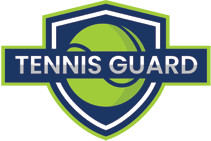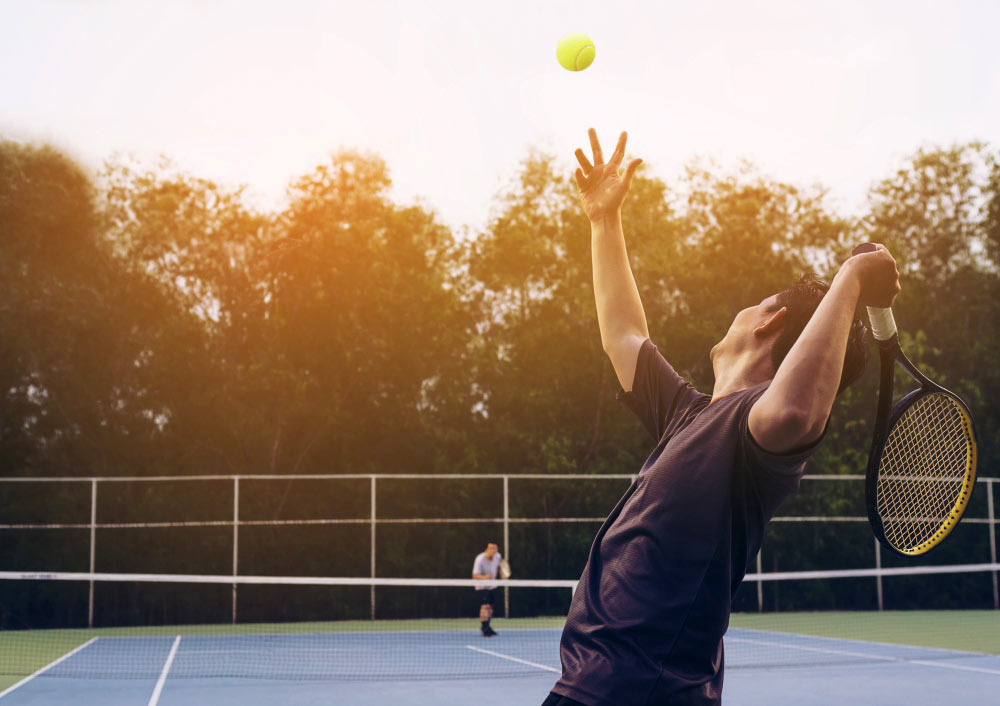One of the most complex strokes in the entire game of tennis is the tennis serve, as it requires a specific set of motions that is executed in a specific order in order for the stroke to be properly effective. The basic fundamentals in this sport are absolutely critical if you want to improve your capabilities as a server in the game of tennis.
There are numerous fundamentals that you need to put into consideration here, including the tennis grip, the position of your feet, your method of throwing the ball, and the position that your body is in prior to making impact with the tennis racquet.
Accomplished tennis players should be more than capable of varying their technique so that they can produce a completely different type of serve as they are required to.
There are three different types of serves that are generally needed during the game: the flat sere, the topspin serve, and the slice serve.
The flat serve is a serve that produces a flat trajectory with a minimum amount of spin. The topspin serve is a serve that produces a high arc and a high amount of bounce. Finally, the slice serve is a serve that produces a lot of topspin and sidespin.
- * Stance: The service that is being executed should absolutely be what determines the right service stance. Your feet should be positioned about shoulder-width apart, with two feet of distance from the court’s center mark. The front foot should be several inches away from the baseline, and the knees should be bent slightly.
- * Grip: The best possible type of grip, if you want to create the most powerful type of serve, is known as the Continental grip. What this does is creates the most powerful release of the wrist, putting the maximum amount of spin on the ball in the process. If you are currently using a forehand grip, and you want to improve your serving capabilities, then you seriously need to consider changing to the continental grip, but keep in mind that an initial change is going to feel unnatural and even clumsy until you get used to it because you need to practice building your speed up to a full level of power if you want this grip to feel properly comfortable.
- * Hold: You need to hold the ball in the same way that you would hold a normal orange, between your thumb and all four of your fingers.
- * Footing: Your foot alignment is going to be determined based on the type of serve that you are doing, but your toes should generally be pointing in the direction of the target.
- * Throw the ball high enough that it is several full inches above where the racquet is, when the racquet is fully extended
Tennis Serve Tips from the Pros
Tip #1 Eyes wide shut
Once you’ve developed a sound service motion, it’s important that you toss the ball into the same spot each and every time. When I was first learning to serve, I was told: ‘You should be able to serve with your eyes closed, because the ball should be in the same spot every time.’ So when I was a kid, I used to practice hitting serves with my eyes closed. I really didn’t care where it went, but if the ball made contact with the racquet strings, that meant the toss was in the right spot.
Paul Annacone
Tip #2 Knock Knock
The key to having a powerful serve is in creating a loop in your backswing and letting your racquet head drop behind you as you toss the ball. This lengthens the swing, and more length means increased power.
If you’re a beginner and don’t feel comfortable with the loop concept, try tapping your back twice during your service motion. It may feel awkward at first, but by practicing your serve and tapping your back twice, you’ll see just how much time you have to make that loop. Then, once you begin to serve without tapping your back, adding the loop to your backswing and dropping your racquet into the back-scratch position will be a breeze. — Dennis Van der Meer
Tip #3 Who’s sorry now?
I know a lot of people are too embarrassed to catch a bad toss and then say ‘sorry’ to their opponent. But by hitting errant tosses, you’ll change the way you swing and lose consistency — and probably lose your balance as well. If you’re a right-hander, toss the ball to one o’clock (slightly to your right). Lefties should toss the ball to the 11 o’clock position (slightly to your left). — Tracy Austin
Tip #4 Make mine a double
The only way you’ll ever improve your second serve is to double-fault at critical times in a match. Yes, that’s right — double fault. Over time, hitting out and going for your second serve will build up your confidence in the shot. — Nick Bollettieri
Tip #5 Swing, batter!
Serving requires using the big muscles of the body. Ask Pete Sampras, Boris Becker, or Goran Ivanisevic where their power comes from and they’ll say their legs, hips, and shoulders.
But this concept can be a complex one. When I’m working at camps and teaching people how to serve — especially kids — I keep it simple. I have the player stand on the baseline and throw a few balls over the net and into the service box. It’s important for developing players to know that a serve is a throw. Once they can throw the ball into the box, I have them pick up their racquets and use the same motion. I’m not as concerned with where the ball goes as I am with them making a good toss and swinging the racquet like they’re going to throw it out of their hands. — Paul Annacone
Tip #6 Same as it ever was
When you’re practicing your serve, go through the same pre-serve rituals you use during a match. Bounce the ball a few times, bring your hands together, and then come to the set position. It doesn’t matter if you hold your hands high or low, or how many times you bounce the ball; just do it the same way you would in a match, every time. The idea behind practice is to create consistency through repetition. If you don’t practice your rituals, they won’t be worth employing during a match. — Lynne Rolley
Tip #7 Snap to it
When snapping your wrist, it’s important to get your racquet head through the impact point quickly. If your wrist leads the way, the frame will be late coming through and the ball is sure to go long. So remember to let the racquet head accelerate and overtake the hand and the wrist. — Dr. Jack Groppel
Tip #8 Power plays
Looking to add more power to your serve? Here are two things you need to do:
1. Stay relaxed. When trying to hit the ball hard, club players tend to tighten up. Try to keep both your arm and your hand loose.
2. Don’t be afraid to use your entire body. Turning your hips and shoulders and getting more leg drive into your motion will add power to your serve.
The one thing you can’t afford to do is only use your arm. The whole body needs to be part of the service chain. — Tom Gullikson
Tip #9 Mix, Match
When you serve from the same spot on the court every time and hit to the same place — and with an identical amount of pace and spin — over and over, you become predictable. And the last thing any server wants to be is predictable.
So the next time you serve, change where you stand, the amount of spin you put on the ball, how hard you hit it, and where you’re aiming in the service box. The more you add in terms of variety, the more you’ll keep your opponent off balance, forcing him to hit weak returns — returns that can set up the rest of your game. And if you find a serve that’s giving your opponent a particularly hard time, keep feeding it to him! — Stan Smith
HOW TO HOT-DOG
Tip #10 Bow wow, Boom Boom
Boris Becker might be an old dog, but he does not need to learn new tricks. He long ago mastered the art of walking the dog, a skill he used for strutting back to the service line.
1. To make like Boris, hold your racquet in an Eastern forehand grip and bounce the ball in front of your dominant side (that’s 2 o’clock for a right-hander, 10 o’clock for a lefty).
2. Then, as you walk, rhythmically tap the ball (with the same side of the strings) behind you, then in front of you, then behind again.
3. Be careful not to break stride by hitting the ball too hard or by walking too fast. It’s all in the loose wrist.
Tip #11 Professional advice
Todd Martin stands closer to the sidelines than most pros when he serves, for three very good reasons:
1. A sharper angle to go wide. ‘By standing farther out, you have a better angle to hit the ball wide off the court — yet still maintain a significant amount of power,’ Martin says.
2. Better return coverage. ‘Since most returns go crosscourt, you’re usually in good position for the next shot. Down-the-line winners off the service return are rare, so you’re playing the percentages.’
3. A higher margin for error. ‘Standing out wide lets you hit over the lower part of the net and gives you more court to serve into.’
Tip #12 Sitting pretty
Players trying to get more drive out of their legs when they serve should pretend they’re sitting down as they toss the ball. (Don’t worry — you won’t have enough time to go too low.) Then, just as you’re ready to swing, explode up and into the ball. — Dr. Jack Groppel
Tip #13 Something to kick around
Developing a topspin serve, also known as a kick serve, is a smart way to make your second ball more consistent and less vulnerable to attack. Instead of a slice (most players’ natural spin) that swings to the side, a serve that’s struck with topspin not only gives your ball added net clearance, but it also makes it kick up after it bounces, thus taking the ball out of the returner’s strike zone. Patrick Rafter is adept at using his kick serve to elicit awkward returns from his opponents. And because the ball moves more slowly through the air, it also gives Rafter more time to get into good volleying position.
How to hit a topspin serve: Using an Eastern backhand grip, toss the ball more in front of your body than off to your dominant side. Arch your back and bend your knees. As you reach forward, make contact on the back side of the ball. (If the ball were a clock, hit it at 6 o’clock and brush up to 12 o’clock.) — Tom Gullikson
Tip #14 It’s a setup
Control, disguise, and variation are more important than sheer pace when it comes to your serve. Using your serve to move an opponent off the court and set up the point is a basic tenet of tennis. One player who does this extremely well is Andre Agassi. He loves to hit a kick serve (which, compared to the flat serves of other pros, has less pace but more pop) to a right-hander’s backhand in the ad court. The spin takes his opponent off the playing surface and mercilessly sets up Agassi’s blistering crosscourt forehand on the next shot. — Nick Saviano
Tip #15 The wrist is history
A loose wrist can salvage a lot of bad ball tosses and make your serve more effective. A wrist that’s locked and firm will make it difficult for a player — at any level — to get spin on the ball, and it’s the spin on your serve that will help you control the ball and maintain consistency. Additionally, a locked wrist will put you at risk of doing serious harm to your elbow.
To make sure your wrist isn’t too tight when you serve, always keep the pinkie finger, ring finger, and middle finger of your racquet hand relaxed. When these fingers tighten, your wrist locks automatically. — Peter Burwash





